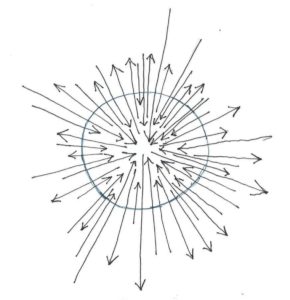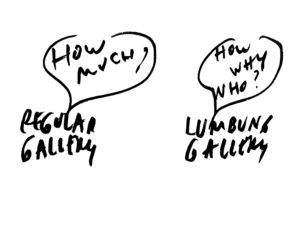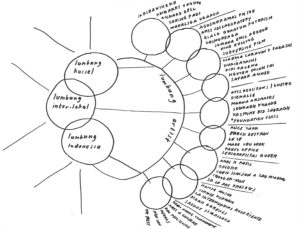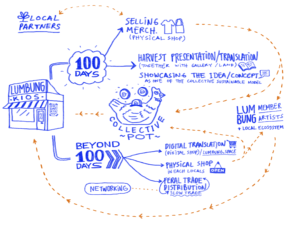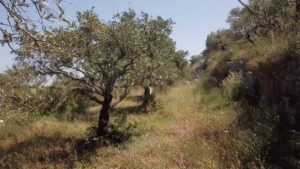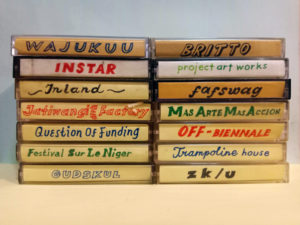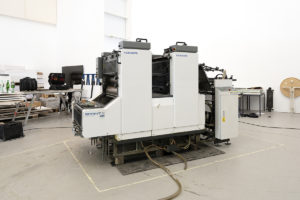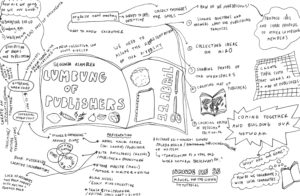Working Group
lumbung Currency
lumbung Currency looks to strengthen and connect the various community currencies that are being built by four of the lumbung members, such as the BeeCoin (ZK/U – Center for Art and Urbanistics), the Cheesecoin (INLAND), the Dayra (The Question of Funding), and the Jalar (Gudskul).

documenta fifteen: lumbung Coin, harvest by Abdul Dube, 2021
Community currencies could enable the lumbung to develop its own economic exchange system where value is decided upon by the community, and exchange happens from direct needs and values. Several learning sessions were organized in the years leading up to documenta fifteen, amongst others with Grassroots Economics, that have already successfully developed community currencies in Kenya as well as with Paul Seidler and Steph Holl-Trieu that have co-developed the Digital Autonomous Organisation (DAO) for the BeeCoin by lumbung member ZK/U – Center for Art and Urbanistics.
The learning sessions led into the existing currency plans of the lumbung members as described below. The processes of development of the currencies is partly on view in the exhibition in Kassel.
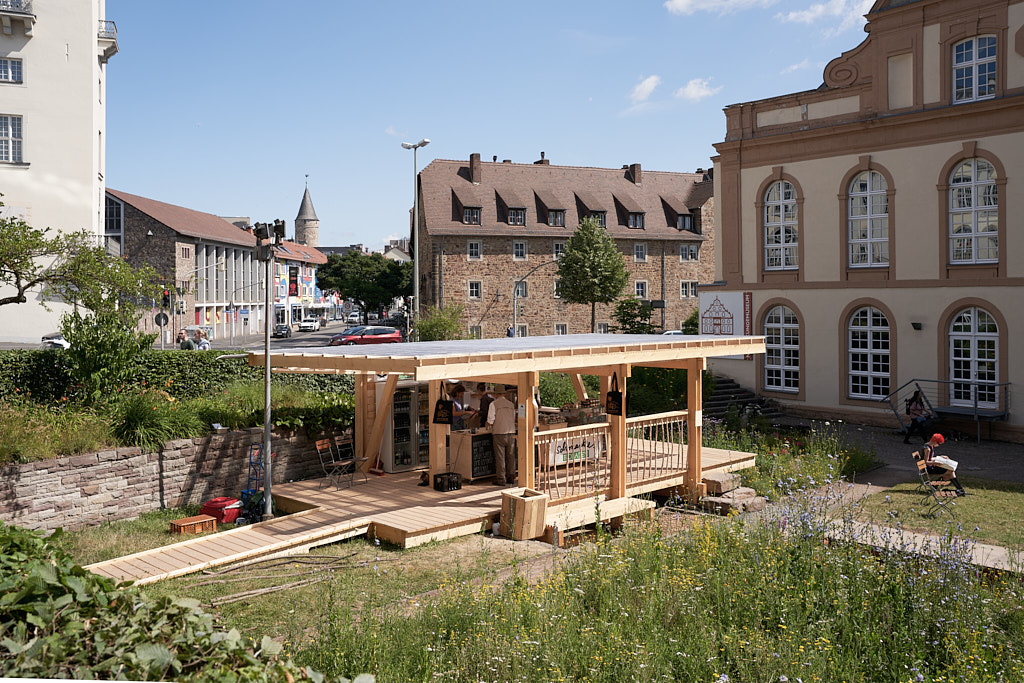
documenta fifteen, INLAND, Cheese Pavillon, Kassel, 2022, Photo: Nicolas Wefers
After documenta fifteen, when the individual currencies have come to fuller life, the lumbung intends to work on ways of connecting the currencies to each other to enable value exchange between local communities outside of often inflexible and bureaucratic mainstream banking and accountability systems.
The common currencies

ZK/U – Center for Art and Urbanistics, Beecoin, lumbung Currency, 2021, Photo: Tomaschko
BeeDAO is an organization of human and nonhuman agents that allows for interspecies democracy, wealth sharing, and knowledge creation. The aim of the organization is to secure and improve the well-being of bees worldwide. Based on web3 technologies and sensor kits that monitor the key life indicators of more than 15 beehives in Kassel, the organization makes decisions in regular assembly meetings.
Operating as a Distributed Autonomous Organization (DAO), BeeDAO is a prototypical experiment, demonstrating the potential for human and nonhuman agents to work towards common goals. Bees and humans can join BeeDAO and become beeholders by donating their data (proof-of-life) or by obtaining an NFT membership. They can nominate delegates to represent their interests or submit proposals that improve bee life as well as help to shape the organization, its charta, its rituals, and the interspecies sharing of wealth. The assembly meetings, regularly held during documenta fifteen at ruruHaus, are open to the public.
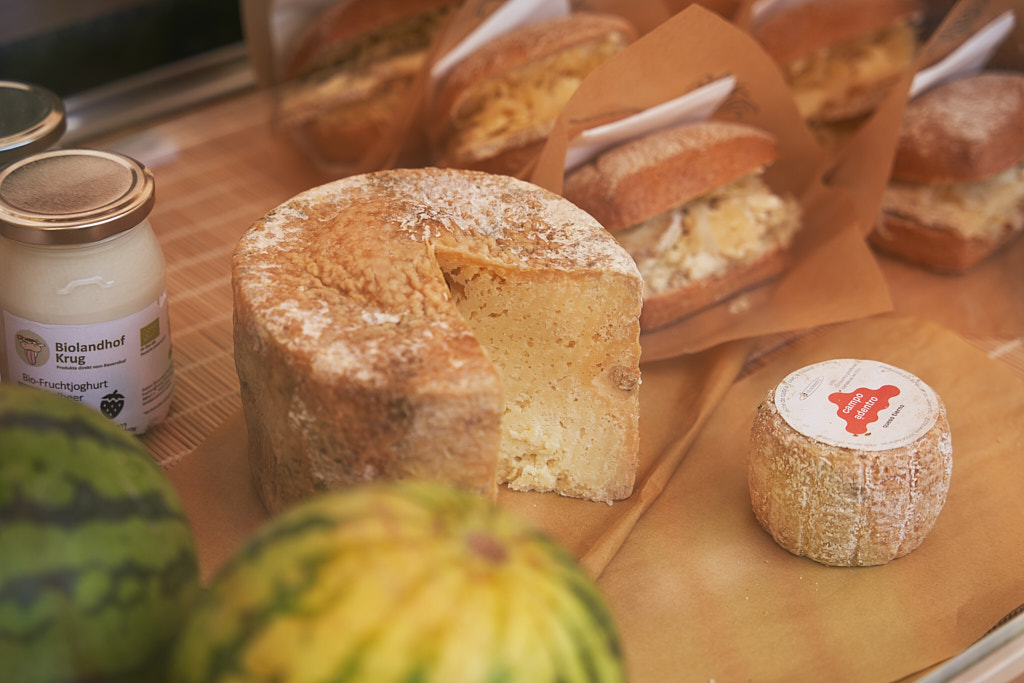
documenta fifteen, INLAND, Kassel, 2022, Photo: Nicolas Wefers
The Cheesecoin was invented as a fictional currency to fund a campaign against a Reality TV company that appropriated the name of INLAND’s project and invaded their area in 2017. It was initiated in collaboration with artist Hito Steyerl.
The currency follows the cheese standard of INLAND, meaning that the collective issues a certain number of Cheesecoins based on the annual amount of cheese produced. In the first stage, the Cheesecoin models an experimental economy, which is in transition from a purely speculative one to a real one. The Cheesecoin is part of a nonlinear economy which mimics neighborhood economies, which run in parallel to capitalist market economies. It sits on top of a conventional market economy for products produced by the collective, such as cheese, intimately related to them, but also refers to traditional gift economies.

The Question of Funding, Dayra, lumbung Currency, 2022
The economic model Dayra by lumbung member The Question of Funding uses blockchain technology for circulating communal economic value. The model is based on the premise that individuals, as well as local businesses and organizations that lack financial resources, nevertheless have resources (material, physical, or intellectual) and knowledge.
The currency thus enables the creation of value for the common good through the exchange and use of these non-monetary resources. This explains the name Dayra, which means “circle” and “circling” in Arabic. In this way, Dayra not only bypasses often restrictive traditional funding models, but ensures a resilient supplementary economy that crisis-affected communities can draw upon. This video explains how the Dayra currency works with an example.
Members of the platform Temujalar.art earn and collect digital points called Jalar for their Jalar Collective Wallet. They generate Jalar by contributing with resources or activities to the platform. They can spend them to join workshops and virtual events, or to build a collective space. The Jalar Collective Wallet resembles the common pot of documenta fifteen, mutually governed by collectives.
Temujalar.art was initiated by Gudskul in 2020, at the beginning of the Covid-19 pandemic, as an online platform for collectives and their art ekosistems. It is based on the belief that online platforms enable knowledge exchange across geographical borders and timezones. In Indonesian, Temu means “to meet”, and Jalar means “to spread”. Temujalar.art is dedicated to artists, collectives, curators, writers, musicians, researchers, teachers, creative people, and the art ekosistem in general. The platform wants to help them to learn, collect experiences, and share knowledge.
By experimenting with these sustainable economic models, the working group lumbung Currency is part of a practice that is intended to continue and be effective beyond the 100 days of documenta fifteen.
